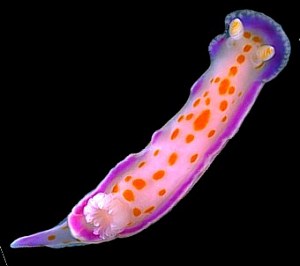
Digidentis perplexa
(Burn, l957)
Order: NUDIBRANCHIA
Suborder: DORIDINA
Family: Chromodorididae
DISTRIBUTION
Southern Australia from southern New South Wales, Victoria, Tasmania, South Australia.
PHOTO
UPPER: Bicheno, eastern Tasmania, May 1985, 18mm long.
LOWER LEFT: Bicheno, eastern Tasmania, May 1985, 21mm long.
LOWER RIGHT: Sisters Is., NW Tasmania, 15m, August 1985, 17mm long.
PHOTOS: Bill Rudman.
Tha mantle is a translucent white colour often tinged with pinkish purple, with a bright purple submarginal band. Inside the purple band are scattered bright orange patches of various shapes and sizes. The simple colourless gills usually have an orange axis and the translucent white rhinophore clubs have an orange line down the posterior midline. Closely packed mantle glands occur all around the mantle edge.
Similarly coloured species
Digidentis perplexa is very similar in colour to Chromodoris ambiguus especially in specimens of D. perplexa where the submarginal purple line is broken into a series of spots. However C. ambiguus is much more ovate with a prominent mantle overlap, whereas in D. perplexa the body is elongate, the mantle overlap along the sides relatively narrow. In C. ambiguus the gills are translucent with white speckling and the rhinophore clubs are a translucent straw colour with white edging to the lamellae while in D. perplexa both gills and rhinophores are white with bright orange markings. The two species can be clearly separated by the differences in their internal anatomy.
Another species, Chromodoris alternata, is also very similar in colour, the main difference being that it has a large orange-brown patch covering the central part of the mantle.
At present this species is known from Tasmania, South Australia and Victoria in south-eastern Australia, the same region in which the similarly coloured C. ambiguus and C. alternata occur.
Reference:
• Rudman,W.B.,(1987). The Chromodorididae (Opisthobranchia : Mollusca) of the Indo-West Pacific: Chromodoris epicuria, C. aureopurpurea, C. annulata, C. coi and Risbecia tryoni colour groups. Zoological Journal of the Linnean Society 90: 305-407.
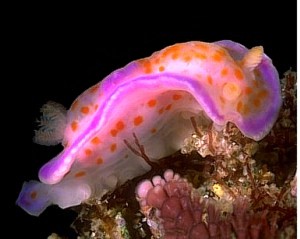
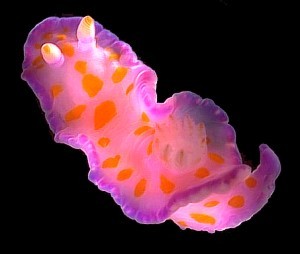
Rudman, W.B., 1999 (June 1) Digidentis perplexa (Burn, l957). [In] Sea Slug Forum. Australian Museum, Sydney. Available from http://www.seaslugforum.net/find/digiperp
Related messages
Digidentis perplexa & friend
March 21, 2008
From: Sarah Quine
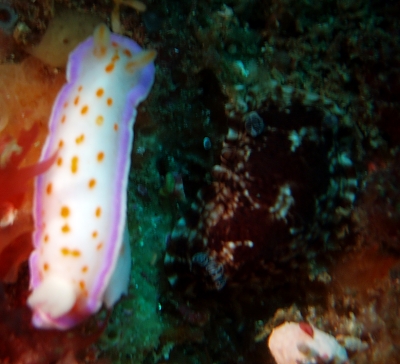
Hi,
On the weekend i was happily photographing this Digidentis perplexa not realising he had a friend. when i got home and uploaded my images i noticed the brown blob at the back had what looked suspiciously like rhinophores. The one good image of the Digidentis is bad of the other critter but the few oput of focus shots show the other one.
I couldn't find him in the Coleman bible and would love to know what he is, i just cant believ i didnt see him when i was photographing the other one. In 4 years of diving in Tasmania i have never seen 2 different species together it really blew me away!
Locality: Lagoon Bay, Tasman Peninsula, 15m, Tasmania, 03-Nov-2007, Rocky shelf under the bull kelp line on the side of a small rocky island. Length: the digi was 18mm so bigger than that. Photographer: Sarah Quine.
i hope you can help,
Kind Regards
Sarah Quine
sarah.quine@portarthur.org.au

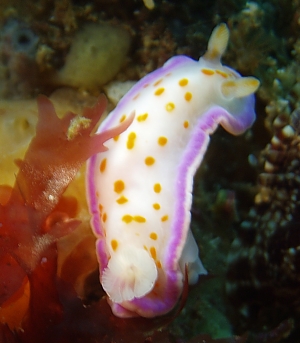
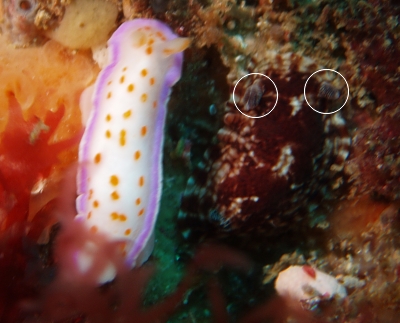
Dear Sarah,
I can't see a brown 'blob' at the back of your photos so I hope you mean the brown blob at the right. The rhinophore-like objects are indeed rhinophores and I have included a close-up of them to show the characteristic leaflets.
This brown animal is a species of Aphelodoris, but as there are a number of very similarly coloured brown species in southern Australia I wouldn't like to guess which one this is on the basis of this photo.
Best wishes,
Bill Rudman
Digidentis perplexa from nthn New South Wales
June 20, 2007
From: Lynda Clarke
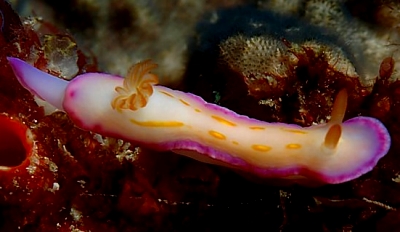
Hi Bill,
Could you please help us to identify this nudibranch, which was photgraphed by my buddy.
Locality: Julian Rocks, 10 to 15 metres, New South Wales, Australia, Pacific, 15 December 2006, rocky reef, vert wall t= 22degrees. Length: 2 to 3cms. Photographer: Andrew Green.
thanks
Lynda
polymath@bigpond.com
Clarke, L., 2007 (Jun 20) Digidentis perplexa from nthn New South Wales. [Message in] Sea Slug Forum. Australian Museum, Sydney. Available from http://www.seaslugforum.net/find/19399Dear Lynda,
This looks a bit like the very variable species Thorunna florens, but details of the colour pattern such as the way the orange pigment lies on the gills and the rhinophores is wrong. My first thought was Digidentis perplexa and on reflection I am pretty sure that's what it is, which is quite interesting since it is a southern Australian species which is not usually found in New South Wales, and certainly not as far north as Julian Rocks.
Best wishes,
Bill Rudman
Digidentis perplexa from S.E. Australia
June 8, 2002
From: John Chuk


Dear Bill,
Here is a shot of Digidentis perplexa that was taken in Port Campbell Harbour, Victoria, Australia on 3 February 1999. The specimen measured 13mm in length and was found actively crawling over green algae at a depth of 4m.
I have included a close up of a portion of the mantle margin on which the mantle glands are clearly visible.
Best wishes,
John.
jchuk@giant.net.au
Chuk, J., 2002 (Jun 8) Digidentis perplexa from S.E. Australia. [Message in] Sea Slug Forum. Australian Museum, Sydney. Available from http://www.seaslugforum.net/find/7124Thanks John,
Bill Rudman
